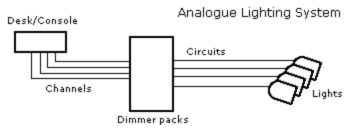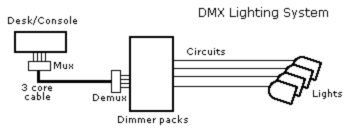What is DMX?
Traditionally, when electrical lighting control systems were developed for the theatre, the three components of the system (console, dimmers and lights) where linked together on a “one wire per channel” basis. This means that if the console has 48 channels, there would have to be 48 individual wires coming out of the back of the console and routed to the dimmer room.
In most theatres, the dimmer room and the lighting gallery are not geographically close to each other (the gallery is usually behind the auditorium whereas the dimmers are usually close to the stage where the majority of the lights are – this is done because the chunkier higher voltage cable forming the dimmer circuit (path from dimmer to lamp) is more expensive and cumbersome, so the less of it there is, the better). This means that the low voltage signal cables need to be routed over quite long distances to get from console to dimmers; most analogue systems output a voltage between 0 and 10 volts representing 0 to 100% brightness. Along their path, they are susceptible to electrical noise from mains cables in close proximity to them and also from signal degradation as the signal voltage will be attenuated more the further it has to travel. There are ways around this, such as shielded cabling and en-route amplifiers, but in the case of the latter, the amplification has to be provided for 48 separate channels. This is expensive and wasteful.
In 1986, USITT (United States Institute for Theatre Technology) proposed a standard known as DMX (Digital Multiplex) which would revolutionise console-dimmer communications.
DMX512 (the 512 represents the number of channels one DMX cable can carry) requires only one 3-core (on older systems, 5-core DMX outputs may be seen – two cores are not used) shielded cable, terminated with XLR connectors, to get all the data channels from the console to the dimmer. The data is sent serially down two cores (the third is the ground pin) known as “positive phase” or “hot” and “negative phase” or “cold”. At the console end, the channels are fed into a multiplexer (mux) which takes the individual channel’s data and encodes it into a format suitable for sending down the DMX line with all the other channels’ data. At the dimmer end, the data is fed into a demultiplexer (demux) and split up again into the individual channels to be fed to individual dimming circuits. In practice, the mux and demux will be incorporated into the console and dimmers respectively, though standalone mux and demux units are available to convert analogue systems into DMX when required.
DMX is advantageous because the DMX cable is less bulky than a 48-way multicore and is therefore cheaper and less cumbersome. If the cable is required to run long distances, any repeater amplifiers need only amplify two signals which is much more efficient and much cheaper. It also allows control of many different pieces of DMX enabled equipment, such as smoke machines and colour scrollers from a central location.